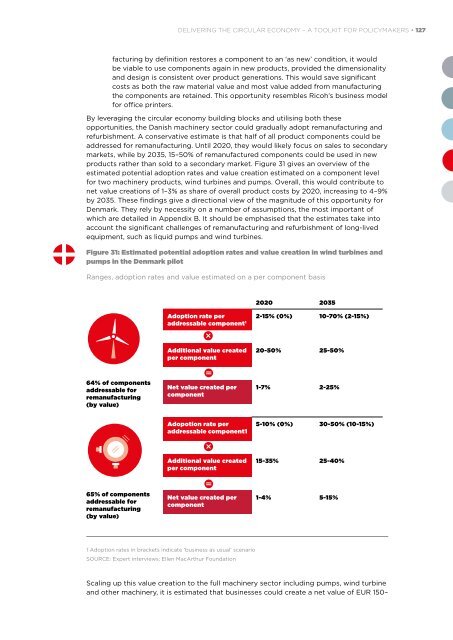DELIVERING THE CIRCULAR ECONOMY A TOOLKIT FOR POLICYMAKERS
20150924_Policymakers-Toolkit_Active-links
20150924_Policymakers-Toolkit_Active-links
Create successful ePaper yourself
Turn your PDF publications into a flip-book with our unique Google optimized e-Paper software.
<strong>DELIVERING</strong> <strong>THE</strong> <strong>CIRCULAR</strong> <strong>ECONOMY</strong> – A <strong>TOOLKIT</strong> <strong>FOR</strong> <strong>POLICYMAKERS</strong> • 127<br />
facturing by definition restores a component to an ‘as new’ condition, it would<br />
be viable to use components again in new products, provided the dimensionality<br />
and design is consistent over product generations. This would save significant<br />
costs as both the raw material value and most value added from manufacturing<br />
the components are retained. This opportunity resembles Ricoh’s business model<br />
for office printers.<br />
By leveraging the circular economy building blocks and utilising both these<br />
opportunities, the Danish machinery sector could gradually adopt remanufacturing and<br />
refurbishment. A conservative estimate is that half of all product components could be<br />
addressed for remanufacturing. Until 2020, they would likely focus on sales to secondary<br />
markets, while by 2035, 15–50% of remanufactured components could be used in new<br />
products rather than sold to a secondary market. Figure 31 gives an overview of the<br />
estimated potential adoption rates and value creation estimated on a component level<br />
for two machinery products, wind turbines and pumps. Overall, this would contribute to<br />
net value creations of 1–3% as share of overall product costs by 2020, increasing to 4–9%<br />
by 2035. These findings give a directional view of the magnitude of this opportunity for<br />
Denmark. They rely by necessity on a number of assumptions, the most important of<br />
which are detailed in Appendix B. It should be emphasised that the estimates take into<br />
account the significant challenges of remanufacturing and refurbishment of long-lived<br />
equipment, such as liquid pumps and wind turbines.<br />
Figure 31: Estimated potential adoption rates and value creation in wind turbines and<br />
pumps in the Denmark pilot<br />
Ranges, adoption rates and value estimated on a per component basis<br />
2020 2035<br />
Adoption rate per<br />
2-15% (0%) 10-70% (2-15%)<br />
addressable component 1<br />
Additional value created<br />
per component<br />
20-50% 25-50%<br />
64% of components<br />
addressable for<br />
remanufacturing<br />
(by value)<br />
Net value created per<br />
component<br />
1-7% 2-25%<br />
Adopotion rate per<br />
addressable component1<br />
5-10% (0%) 30-50% (10-15%)<br />
Additional value created<br />
per component<br />
15-35% 25-40%<br />
65% of components<br />
addressable for<br />
remanufacturing<br />
(by value)<br />
Net value created per<br />
component<br />
1-4% 5-15%<br />
1 Adoption rates in brackets indicate ‘business as usual’ scenario<br />
SOURCE: Expert interviews; Ellen MacArthur Foundation<br />
Scaling up this value creation to the full machinery sector including pumps, wind turbine<br />
and other machinery, it is estimated that businesses could create a net value of EUR 150–



